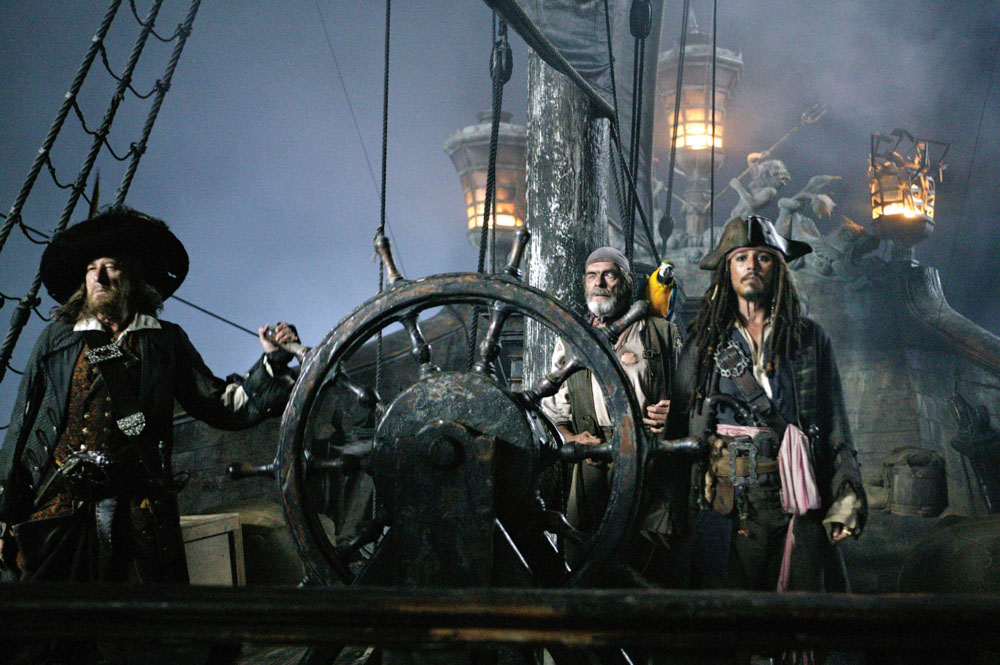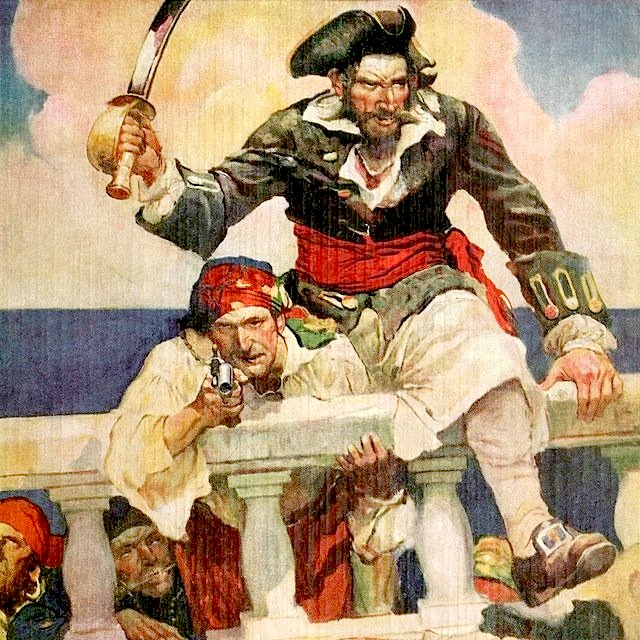|
THE GOLDEN AGE OF PIRACY
Please use our A-Z INDEX to navigate this site
|
|
Made famous again by the Disney series of pirate films, Tortuga and Port Royal must be included in any yarn about piracy, to give the stories an authentic flavour.
Thousands of pirates were active between 1650 and 1720. These years are sometimes known as the 'Golden Age’ of piracy: Yo-ho-ho and a bottle of rum, spawning Robert Louis Stevenson's 'Treasure Island.'
Famous pirates from this period include Henry Morgan, William 'Captain' Kidd, 'Calico' Jack Rackham, Bartholomew Roberts and the fearsome Blackbeard (Edward Teach).
We are sure you've heard the fables and the legends of the Caribbean Pirates, their legacy living on through the stories told by the entertainment industry. From Errol Flynn to Johnny Depp, we are well familiar with a romanticized edge to pirates, these tough entrepreneurs of yesteryear.
Pirates are criminals on the open sea who use coercion, intimidation and violence to rob people of their cargo, transport and liberty. The majority of pirates were young men in their 20s who were skilled at sailing and open to seize an opportunity.
Pirates have been around for a very long time, ever since Christopher Columbus and Magellan paved the way with ships capable of navigating the Atlantic reliably.
In our electronic, digital, age a new form of piracy is prevalent, known as copying (cut & paste) or plagiarism, blurred by the repetition of articles reproduced on literally millions of websites. But that has nothing to do with the Golden Age of sail.
What was the Golden Age of Piracy really like and why did so many people escape to a life of crime on the ocean wave.
WHY BECOME A PIRATE?
Conditions have to be just right for piracy to boom. First, there must be many able-bodied young men (preferably sailors) out of work and desperate to make a living. There must be shipping and commerce lanes nearby, full of ships that carry either wealthy passengers or valuable cargo. There must be little or no law or government control. The pirates must have access to weapons and ships. If these conditions are met, as they were in 1700 (and in present-day Somalia), piracy may become common.
Sailors in the 18th century had a choice: they could join the navy, work on a merchant ship, or become a pirate or privateer. Conditions on board the naval and merchant vessels were abominable. The men were routinely underpaid or even cheated of their wages completely, the officers were strict and harsh, and the ships were often filthy or unsafe. Many served against their will. Navy "press gangs" roamed the streets when sailors were needed, beating able-bodied men into unconsciousness and putting them on board a ship until it sailed.
THE GOLDEN AGE
What
you can be sure of is that when there’s a profit to be made, many States will have
their hands in the pie.
Also known as Trade Wars, privateering played an important role in naval strategy all the way into WWII, and continues today in various evolved forms. Countries vie with each other to sell goods overseas as exports, using deception as to the geographical origin of products, until they are delivered.
Latterly, privateers or “corsairs” carried the ‘letter of marque and reprisal’ which was essentially a license to kill, a sort of 007 of yesteryear. Or at least attack and capture enemy vessels to bring before admiralty courts for condemnation and sale.
Privateers cruised the ocean for profit under the veil of patriotism, raiding and plundering ships in a privately owned and operated endeavour within a legal framework.
This
was the vague distinction between the celebrated privateer and the universally reviled pirate,
or buccaneer. The name is 'Buccaneer' is derived from the French term ‘boucanier’ – an instrument used to smoke strips of meat over an open fire.
Pirates sail
without the support of any Monarch.
The Peace Treaty of Westphalia (1648) outlawed privateering, causing many corsairs to take up piracy. Essentially, they were doing the exact same job but with their own personal flag replacing their birthplace.
Other factors that contributed to the Golden Age of Piracy in the Caribbean included the increasingly valuable cargoes being shipped between Europe and the New World, the abundance of well-trained merchant sailors, and the ineffective governance of overseas colonies.
The Treaty of Utrecht (1713), which ended the War of the Spanish Succession and the quarrelling of Great Britain
Vs France and Spain, caused even more sailors to become pirates. Mixed with a healthy
dose of self-determinism, the stage was set for piracy to blossom as an
alternative living, where one could make your mark on the world.
Edward Teach (Blackbeard) did his part for the crown before starting the Flying Gang in the pirate haven of Nassau, aiming high and cooking up grand schemes. Their goal, not unnaturally given the loose controls at the time, was to govern a country of their own. They worked to turn Nassau into a land of liberty and freedom for all those who desired an escape from the bonds of Imperial rule. A kind of declaration of independence.
In 1706, the governor of the Bahamas jumped ship, leaving it open to anarchy and the self-election of pirate Benjamin Hornigold as governor, with the declaration that Nassau was to be a Pirate Republic.
In the words of the Governor of Bermuda at the time, Nassau was “a nest of infamous bastards.”
Hornigold was one of the original pirates, who began as a privateer, left without gainful employment following the war. For some years he refused to attack English ships out of a sense of loyalty to his home country. In the beginning, this was so for many privateers turned pirate.
As
the English Navy tightened it's grip, this all came to an abrupt end at
the end of a rope for many Caribbean Pirates of the Golden
Age, who refused to accept pardon.
Having watched a few swashbuckling movies, you will be familiar with the image of pirate ships, its cannons roaring and bloodthirsty crews, where the black flag is hoisted to signal an attack.
The
Jolly Roger skull-and-crossbones is
one of the most famous flags. These were used by pirates to strike fear in the hearts of their targets.
You can though, pay your respects to these men and women at museums, both on land and underwater, due to the high incidence of shipwrecks in the West Indies region, beset as it is by hurricanes and tropical storms, and when you mix that with the shallow waters of the Caribbean reefs, the result is inevitable.
With the advent of Scuba gear, you can dive these wrecks and get a sense of the history through the timber ghosts of the once grand and powerful vessels that ruled the sea.
One interesting innerspace city, lost beneath the waves is Port Royal, the subject of an earthquake and tsunami, that claimed Captain Henry Morgan's grave. His buried treasure was never recovered from Jamaica or other Caribbean island.
This is the inspiration for a John Storm ocean awareness adventure, featuring the Elizabeth Swann, an artificially intelligent ship, powered by renewable energy.
http://www.historytoday.com/david-cordingly/pirates-and-port-royal
....
Please use our A-Z INDEX to navigate this site
|
|
|
This website is Copyright © 2022 Cleaner Ocean Foundation Ltd
|

